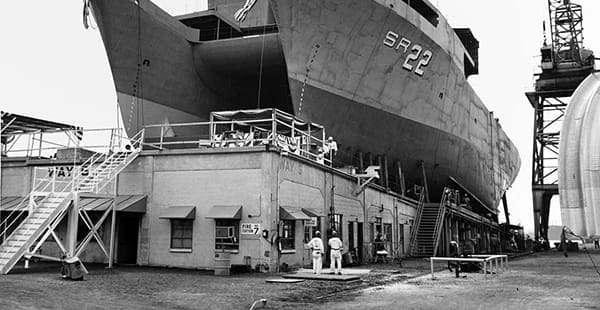Alabama Drydock and Shipbuilding Company History
Alabama Drydock and Shipbuilding Company (ADDSCO) was important to Mobile, Alabama, and the nation during the 20th century. It built and maintained ships for the U.S. Navy during both World Wars. However, mid-century industries commonly used dangerous asbestos products on ships and at shipyards.
During World War I, the company employed over 4,000 workers. The workers built steamships, barges and minesweepers at ADDSCO dry docks on Pinto Island. ADDSCO continued to work on small repair contracts between the wars and built a tunnel to connect Mobile to the neighboring Baldwin County.
The company grew to over 30,000 employees during World War II. It also diversified its workforce, employing women as welders and in other non-office jobs. ADDSCO continued to build, refit and maintain ships during this period.
After World War II, ADDSCO laid off many wartime workers. By the 1960s, it only had about 2,000 employees, working primarily to repair ships. Before it closed in 1988, it also built rescue ships, several oil platforms and another tunnel. After its closure, the company divided up the facilities and sold them to several companies.
Alabama Drydock and Shipbuilding Company History at a Glance
- Location: Mobile, Alabama
- Owner(s): ADDSCO, Alabama Shipyard, Atlantic Marine, BAE Systems
- Years of Operation: 1916 – 1988
- Wartime Operations: World War I (WWI), World War II (WWII)
- Noteworthy Ships: Arickaree, SS Manhattan
- Types of Ships Built/Serviced: Barges, cargo vessels, minesweepers, oil tankers, rescue ships, steamships
ADDSCO workers were potentially exposed to asbestos on the job. For decades, the U.S. Navy, which contracted with ADDSCO, required asbestos in hundreds of shipbuilding materials. Asbestos exposure can lead to diseases like mesothelioma and lung cancer.
Notable Ships Built and Repaired
ADDSCO built many ships as part of its business. The company’s World War II efforts included building over 100 oil tankers. It also built minesweepers, cargo vessels and other ship types. Many of these ships were made with asbestos materials. People who built, repaired and refitted them faced asbestos exposure.
Arickaree (T2-SE-A1)
The Arickaree was the first oil tanker ADDSCO built. At the time, it was the largest vessel ever constructed along the Gulf Coast. The ship was part of a generation of tankers called T2s. They played an important role in supplying oil to other Navy ships during World War II.
Workers laid the keel in 1942 and finished the tanker in 1943. The finished ship included two steam turbines made by General Electric (GE). For many years, GE produced turbines that contained asbestos. Builders and turbine operators may have come into contact with asbestos while working with or around these turbines.
After World War II, the ship served as an oil tanker for several private companies, including the Alexander S. Onassis Corporation. It was eventually disassembled in 1968.
SS Manhattan
Bethlehem Steel Corporation built the SS Manhattan in 1961. At the time, the steam tanker was the largest merchant ship ever built in the United States. Between 1968 and 1969, the ship was converted into an icebreaker. ADDSCO participated in the conversion.
The discovery of a large oil field near Prudhoe Bay, Alaska, spurred the conversion. The ship was cut into four sections to speed up the conversion process. ADDSCO received the midship section.
The ship completed its journey to Prudhoe Bay in 1969. It eventually resumed its role as an oil tanker before being scrapped in 1987.
Resources for Mesothelioma Patients
Asbestos at Alabama Drydock and Shipbuilding Company
ADDSCO operated at a time when asbestos use was common in the shipbuilding industry. As a Navy contractor, it built ships to military specifications. For many years, the military required contractors to use asbestos in hundreds of materials.
The Navy was worried that other materials might not perform as well as those with asbestos, which made products more durable and heat resistant. Navy officials believed any material could be safe if properly handled. But asbestos, with its microscopic fibers, can be difficult to handle safely.
Asbestos Exposure at Alabama Drydock and Shipbuilding Company
At its peak, ADDSCO was the largest employer in Mobile, Alabama. In 1943, it had about 30,000 employees working to build, repair and refit ships. Its operations coincided with a period of heavy asbestos use in the shipbuilding industry.
Trades and other occupations that faced asbestos exposure risks at shipyards include:
- Boiler workers
- Construction workers
- Electricians
- Engineers
- HVAC workers
- Insulators
- Joiners
- Laborers
- Masons
- Mechanics
- Molders
- Pipefitters
- Plant workers
- Plumbers
- Riveters
- Sheet metal fabricators
- Shipfitters
- Shipwrights
- Steamfitters
- Welders
Those exposed to asbestos at ADDSCO facilities risk developing mesothelioma and other asbestos diseases. Mesothelioma patients and their families may be able to get compensation to help pay for treatment and other costs.
Asbestos Settlements for Alabama Drydock and Shipbuilding Company
Workers who spent time at ADDSCO and later developed mesothelioma may file lawsuits against the company. Lawsuits may result in trial verdicts or settlements between the victim and the company.
ADDSCO has faced asbestos lawsuits and settled with victims. The following are just a few examples of settlement amounts paid by the company:
- $1,367,964 for a 62-year-old construction and plant worker
- $660,028 for a 73-year-old laborer and shipyard worker
People who worked at ADDSCO may also be able to seek compensation from companies that supplied asbestos materials to the shipyards. Mesothelioma patients and their families can reach out to asbestos attorneys to explore their legal options.
Asbestos Trusts Associated With Alabama Drydock and Shipbuilding Company
Companies that exposed people to asbestos have had hundreds of thousands of lawsuits filed against them. The barrage of lawsuits has caused some to file for bankruptcy. Often, these bankrupt companies set up asbestos trust funds to pay current and future victims.
Victims and their loved ones may be eligible to file trust fund claims in addition to filing a lawsuit. You can discuss all of your compensation options with a mesothelioma lawyer.
Asbestos Trust Funds and Eligible Years of Employment
The following companies provided asbestos products to ADDSCO. After exposing innocent people to asbestos and facing many asbestos lawsuits, these companies filed for bankruptcy and created trust funds to pay victims. If an individual worked at ADDSCO and developed a disease such as mesothelioma, they may be able to file a claim against these companies’ trusts.
| Asbestos Company Name | Eligibility Start Date | Eligibility End Date |
|---|---|---|
| Armstrong International Inc. | 1/1/1940 | 12/31/1982 |
| Babcock & Wilcox (B&W) | 1/1/1940 | 12/31/1982 |
| Combustion Engineering | 12/31/1982 | |
| Eagle-Picher Industries | ||
| Keene Corporation | 1/1/1926 | 12/31/1982 |
| NARCO | 1/1/1972 | 12/31/1977 |
| Owens-Corning | 1/1/1938 | 12/31/1982 |
| Owens-Corning/Fibreboard | 1/1/1928 | 12/31/1982 |
| Pittsburgh Corning | 1/1/1970 | |
| Shook & Fletcher | ||
| U.S. Gypsum Company | 1/1/1940 | 1/2/1968 |









